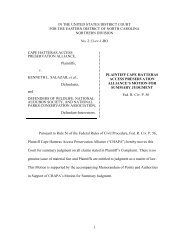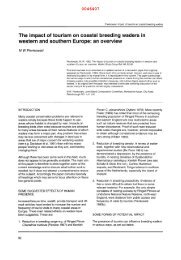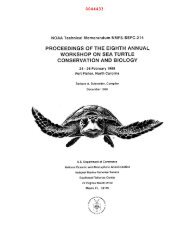The Impact of Vehicles on Dune and Grassland Vegetation on a ...
The Impact of Vehicles on Dune and Grassland Vegetation on a ...
The Impact of Vehicles on Dune and Grassland Vegetation on a ...
You also want an ePaper? Increase the reach of your titles
YUMPU automatically turns print PDFs into web optimized ePapers that Google loves.
0042130<br />
176 <str<strong>on</strong>g>Impact</str<strong>on</strong>g> <str<strong>on</strong>g>of</str<strong>on</strong>g> vehicles <strong>on</strong> dune <strong>and</strong> grassl<strong>and</strong> vegetati<strong>on</strong><br />
Sediment characteristics <strong>and</strong> penetrati<strong>on</strong> resistance<br />
Surface samples <str<strong>on</strong>g>of</str<strong>on</strong>g> sediment (top 3 em) were collected at 10 m intervals al<strong>on</strong>g the<br />
transects. Samples were sieved to remove the silt/clay fracti<strong>on</strong> <strong>and</strong> materials greater than<br />
2 mm. <str<strong>on</strong>g>The</str<strong>on</strong>g> silt-clay fracti<strong>on</strong> was not measured. Following removal <str<strong>on</strong>g>of</str<strong>on</strong>g> organic debris with<br />
sodium hypochlorite, the samples were analysed in a st<strong>and</strong>ardized settling tube <strong>and</strong><br />
classified according to Folk (1974).<br />
Compacti<strong>on</strong> was assessed using a Soiltest c<strong>on</strong>e penetrometer. This instrument measures<br />
the shearing resistance <str<strong>on</strong>g>of</str<strong>on</strong>g> soils. <str<strong>on</strong>g>The</str<strong>on</strong>g> instrument c<strong>on</strong>sists <str<strong>on</strong>g>of</str<strong>on</strong>g> a 30 degree c<strong>on</strong>e (3·2 cm 2 base<br />
area), a 46 em extensi<strong>on</strong> rod, a proving ring, <strong>and</strong> a dial indicator.<br />
A total <str<strong>on</strong>g>of</str<strong>on</strong>g> 504 determinati<strong>on</strong>s were taken at 1 em, 5 em, <strong>and</strong> 15 em depths in each<br />
vegetati<strong>on</strong> type in order to establish site c<strong>on</strong>diti<strong>on</strong>s. Depth was recorded as positive<br />
distance from the surface. Also, determinati<strong>on</strong>s were made specifically in vehicle tracks<br />
at the impacted beach site. <str<strong>on</strong>g>The</str<strong>on</strong>g>se were accomplished by taking 100 readings at various<br />
depths al<strong>on</strong>g transects perpendicular to the track. Least squares regressi<strong>on</strong> analysis was<br />
applied to soil resistance readings in the tracks.<br />
RESULTS<br />
Physiographic-vegetati<strong>on</strong>al analysis<br />
Fort Fisher <strong>and</strong> Bald Head Beaches were subjected to severe oceanic overwash prior<br />
to 1900, during 1954 (Hurricane Hazel), <strong>and</strong> most recently in 1962 (Ash Wednesday<br />
Storm) (Cleary & Hosier, 1979). We attribute the present differences in vegetati<strong>on</strong> <strong>and</strong><br />
physiography to the presence or absence <str<strong>on</strong>g>of</str<strong>on</strong>g> vehicles. According to local residents the<br />
number <str<strong>on</strong>g>of</str<strong>on</strong>g> vehicles using the Fort Fisher Beach increased in the mid- to late 1960s.<br />
At both locati<strong>on</strong>s, the beach-berm crests at approximately 3· 5 m above msl <strong>and</strong> the isl<strong>and</strong><br />
surface slopes gently to elevati<strong>on</strong>s where tidal marsh vegetati<strong>on</strong> begins, approximately<br />
40 em above msl. <str<strong>on</strong>g>The</str<strong>on</strong>g>re are more dunes at Fort Fisher Beach (Figs 2 <strong>and</strong> 3).<br />
Importance values for species within each vegetati<strong>on</strong> associati<strong>on</strong> suggest a similarity<br />
<str<strong>on</strong>g>of</str<strong>on</strong>g> dune vegetati<strong>on</strong> at each site <strong>and</strong> a dissimilarity between grassl<strong>and</strong> systems. Eleven <str<strong>on</strong>g>of</str<strong>on</strong>g><br />
the nineteen species found in the dunes are comm<strong>on</strong> to both dune sites. Major differences<br />
in importance values occur <strong>on</strong>ly with Triplasis purpurea, Eriger<strong>on</strong> canadensis, <strong>and</strong><br />
Strophostyles he/vola (Table 1). Within the grassl<strong>and</strong> associati<strong>on</strong>, Fort Fisher Beach has<br />
less than half the number <str<strong>on</strong>g>of</str<strong>on</strong>g> species found <strong>on</strong> Bald Head Beach. Only ten species are<br />
comm<strong>on</strong> to both areas from a total flora <str<strong>on</strong>g>of</str<strong>on</strong>g> thirty-eight species. Nineteen species found<br />
in the grassl<strong>and</strong> at Bald Head are not found in the grassl<strong>and</strong> at Fort Fisher, while <strong>on</strong>ly<br />
two species are found in the latter <strong>and</strong> not in the former site. Grassl<strong>and</strong> species such as<br />
Fimbristylis spadicea, Solidago sempervirens, <strong>and</strong> Andropog<strong>on</strong> virginicus are lacking at<br />
Fort Fisher. Fort Fisher Beach has a higher cover <str<strong>on</strong>g>of</str<strong>on</strong>g> Borrichia frutescens, Lim<strong>on</strong>ium<br />
carolinianum, <strong>and</strong> Salicornia virginica, species usually comm<strong>on</strong> in salt flats or salt pans.<br />
While Bald Head Beach has nearly equal amounts <str<strong>on</strong>g>of</str<strong>on</strong>g> grassl<strong>and</strong> <strong>and</strong> dune type vegetati<strong>on</strong>,<br />
the dune associati<strong>on</strong> dominates at Fort Fisher. Also, the latter has lower mean cover<br />
values (Fig. 2). If quadrats c<strong>on</strong>taining a track are removed from c<strong>on</strong>siderati<strong>on</strong>, the<br />
average cover <str<strong>on</strong>g>of</str<strong>on</strong>g> the dunes <strong>on</strong> Fort Fisher Beach (impacted) is increased to 16·4%, nearly<br />
the same as Bald Head Beach (n<strong>on</strong>-impacted). This is further illustrated by the high<br />
number <str<strong>on</strong>g>of</str<strong>on</strong>g> unvegetated quadrats in the dunes (Fig. 3 <strong>and</strong> Table 2).<br />
Table 2 shows that vehicles alter nearly all the parameters which were measured. <str<strong>on</strong>g>The</str<strong>on</strong>g><br />
total number <str<strong>on</strong>g>of</str<strong>on</strong>g> species <strong>and</strong> species diversity both decline in vegetati<strong>on</strong> types where












